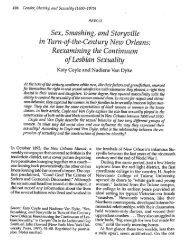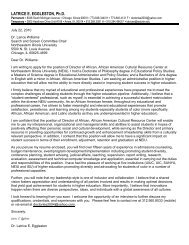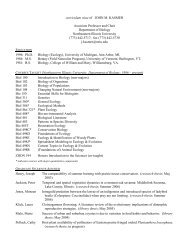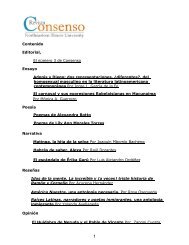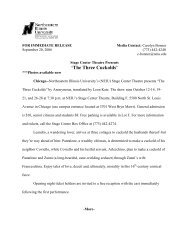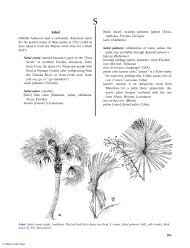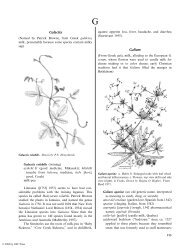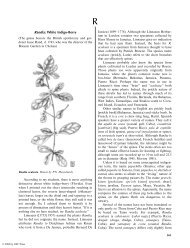Herba Cana - Northeastern Illinois University
Herba Cana - Northeastern Illinois University
Herba Cana - Northeastern Illinois University
Create successful ePaper yourself
Turn your PDF publications into a flip-book with our unique Google optimized e-Paper software.
© 2004 by CRC Press<br />
The Ethnobotany 495<br />
beans cultivated by the Timucua in northeastern<br />
Florida in 1562.<br />
Earlier explorers also found beans farther north<br />
(Hedrick 1919). Florentine navigator Giovanni da<br />
Verrazzano (alias John Verazanno) (1485 /1528) found<br />
them among the indigenous people of NorumBega,<br />
Maine, in 1524. As the first European visitor to the<br />
New England coast, he had never before seen kidney<br />
beans. He wrote of the people, presumably the<br />
Pequod, ‘‘Their ordinarie food is of pulse, whereof<br />
they have great store, differing in colour and taste<br />
from ours, of good and pleasant taste.’’ Later, Jacques<br />
Cartier found beans ‘‘of every color’’ among the<br />
Hurons at the mouth of the St. Lawrence River of<br />
Quebec in 1535.<br />
In the same region, Samuel de Champlain (1567 /<br />
1635) found the Abenaki of the Kennebec River on<br />
southern Maine eating multicolored beans in 1605,<br />
and Capt. John Smith (1580 /1631) knew them among<br />
the New England tribes in 1614 when the Pilgrims first<br />
landed. Before 1670, John Josselyn wrote of ‘‘French<br />
beans: or rather, American beans. The herbalists call<br />
them kidney-beans from their shape and effects: for<br />
they strengthen the kidneys. They are variegated<br />
much, some being bigger, a great deal, than others;<br />
some white, black, red, yellow, blue, spotted’’ (Hedrick<br />
1919).<br />
Harriot ([1590] 1972) wrote of North Carolina that<br />
the okindgier was ‘‘called by vs beanes, because of in<br />
greatnesse and partly shape they are like to the Beanes<br />
in England, sauing that they are flatter, of more divers<br />
colours, and some pide. The leafe also of the stemme is<br />
much different. In taste they are altogether as good as<br />
our English peaze.’’<br />
Beans are documented as grown for food among<br />
the Abenaki, Algonquin, Apache, Aztecs, Cherokee,<br />
Choctaw, Creek, Delaware, Havasupai, Huron, Iroquois,<br />
Menomin, Navajo, Ojibwa, Onondaga, Papago,<br />
Pequod, Potawatomi, Santee, Seminoles, Sia, Tewa,<br />
Tuscarora, and Zuni (Romans [1775] 1961, Bartram<br />
1719, Hedrick 1919, Smith 1933, Swanton 1946,<br />
Berkeley and Berkeley 1982, Moerman 1998). All the<br />
agricultural tribes in the eastern United States surely<br />
made use of them.<br />
Harriot ([1590] 1972) wrote that the people of<br />
Virginia cooked corn and beans together to ‘‘make<br />
them victuall either by boyling them all to pieces into a<br />
broth; or boiling them whole vntill they bee soft and<br />
beginne to breake as is vsed in England, eyther by<br />
themselues or mixtly together: Sometime they mingle<br />
of the wheate with them. Sometime also beeing whole<br />
sodden, they bruse or pound them in a morter, &<br />
therof make loaues of lumps of dowishe bread, which<br />
they vse to eat for varietie.’’ Romans ([1775] 1961)<br />
found the Choctaw doing much the same by boiling<br />
corn and beans together, and calling it holhponi. We<br />
now call this mixture ‘‘succotash’’ (an Algonquian<br />
word akin to Narraganset msekwatas; in use by 1751).<br />
Capt. John Smith recorded for Virginia a dish of<br />
unripened corn, roasted in hot ashes, and eaten boiled<br />
with beans during the winter. He called it pausarowmena<br />
or pausarawmena. Le Page Du Pratz found the<br />
Natchez in 1758 cooking corn bread with beans, a dish<br />
they called co oëdlou (Swanton 1946).<br />
The Caddo of southwestern Arkansas, northwestern<br />
Louisiana, and adjacent Texas had a unique bean<br />
dish. Henri de Joutel wrote about 1615 that they ‘‘do<br />
not make much mystery in preparation of them.’’<br />
These people cooked them in a big pot without any<br />
preparation and kept them covered with leaves until<br />
they were almost done. Then, they poured warm,<br />
salted water over them before serving. Those eating the<br />
pods were expected to eat strings, stems, and other<br />
parts or remove the pieces they did not want (Swanton<br />
1946). This tribe was also unusual in salting their food.<br />
By the time Bartram ([1791] 1958) was among the<br />
Seminoles of northern Florida in the 1770s, he found<br />
them growing ‘‘beans’’ (Phaseolus). They were also<br />
growing what he called ‘‘pease,’’ the introduced cowpea,<br />
Vigna unguiculata. Indeed, along with native<br />
produce, Bartram recorded a number of other introduced<br />
plants among these villagers.<br />
At Palatka (from Creek pilotaikita, crossing), in<br />
what is now Putnam County, Florida, Bartram visited<br />
a Seminole garden. The field was planted ‘‘chiefly with<br />
corn (Zea), Batatas [Ipomoea batatas], Beans [Phaseolus<br />
vulgaris], Pompions [Cucurbita pepo], Squashes<br />
(Cucurbita verrucosa) [C. pepo], Melons (Cucurbita<br />
citrullus) [Citrullus lanatus], Tobacco (Nicotiana) &c.<br />
are abundantly sufficient for the inhabitants of the<br />
village.’’ At the same village he later wrote, ‘‘The fields<br />
surrounding the town and groves were plentifully<br />
stored with’’ exotic crops including peas (Vigna<br />
unguiculata), potatoes (Solanum tuberosum), peaches<br />
(Prunus persica), figs (Ficus cairica), and oranges<br />
(Citrus sinensis).<br />
Later Bartram visited Cuscowilla (taska, warrior,<br />
weli, plunderer, Choctaw), near the northwestern<br />
corner of Tuscawilla Lake, and east of the present<br />
Micanopy, Alachua County, close to the Alachua<br />
savanna. There the Seminoles planted, ‘‘but little here<br />
about the town, only a small garden spot at each<br />
habitation, consisting of a little Corn, Beans, Tobacco,<br />
Citruls [Citrullus lanatus], &c.’’ Instead, they had their<br />
major crops elsewhere.<br />
Bartram also described an extensive maize field<br />
near Cowee (a Cherokee town formerly on the Little<br />
Tennessee River, Macon County, NC). He rode ‘‘near<br />
two miles through Indian plantations of Corn, which<br />
was well cultivated, kept clean of weeds and was well





